Last Chance to Catch NYC's Holiday Notalgia Train
We met the voices of the NYC subway on our nostalgia ride this weekend!


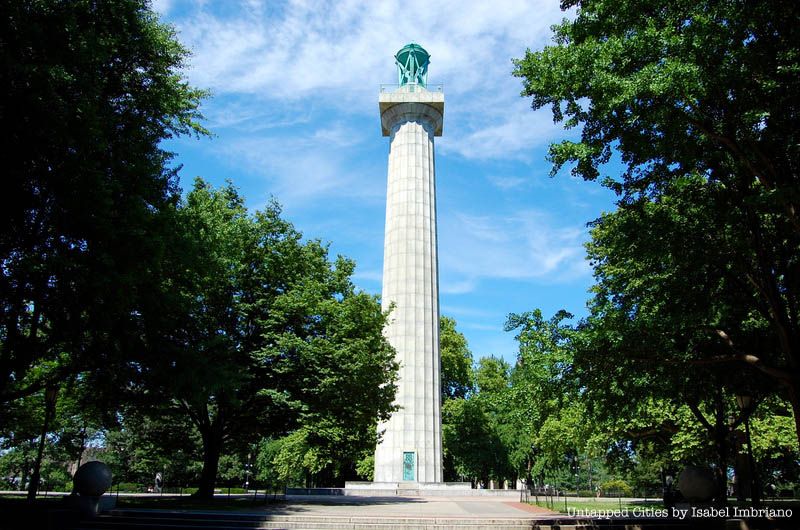
Boasting ethnically diverse restaurants, stunning architecture and renowned institutions, Fort Greene is a thriving urban cultural hub that’s trendy, yet simultaneously community-oriented. With a history dating back to the Revolutionary War, it’s no surprise that the neighborhood is distinguished by architectural and historical artifacts such as the Prison Ship Martyrs’ Monument in Fort Greene Park, formerly the site of an actual fort. Yet, amidst this, you’ll also find quaint, tree-lined streets and beautifully preserved brownstones from the mid-19th century.
It is all these elements combined that help to make Fort Greene the brilliantly vibrant and charming neighborhood that it is today. With so much to see and do, we’ve rounded up a list of places, focusing on the hidden, the historical and the truly unique. Here are 17 must-visit places to check out in Fort Greene:
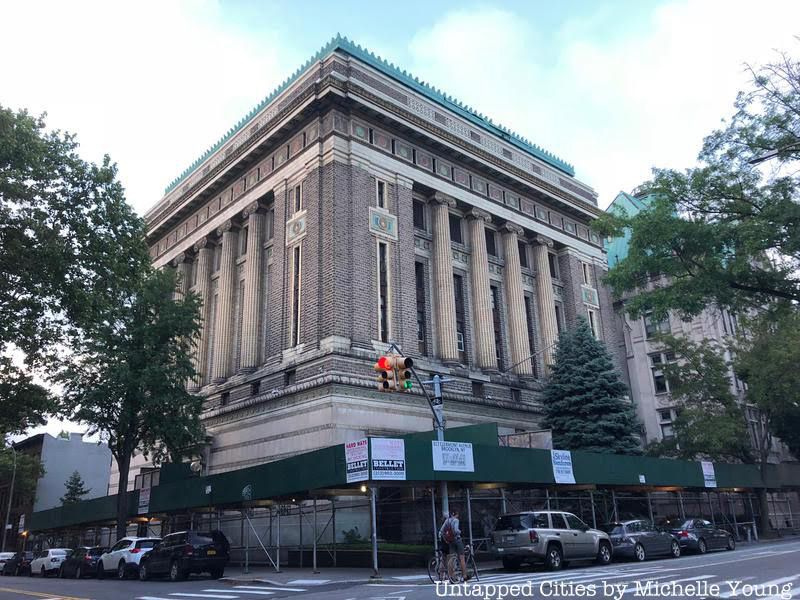
Fort Greene is home to several architectural masterpieces, the most famous among these being the Brooklyn Masonic Temple. Built in 1909, this Masonic granite temple is regarded as one of the most beautiful structures in the United States and features an impressive brick, marble and terra cotta exterior. According to The New York Times, the original intent of this structure was to be a meeting place for the Masons of Brooklyn (hence the name). In 1977, it was then sold to a “clandestine” Mason group. This group couldn’t afford the daunting cost of upkeep, so they rented out the space on a regular basis. The building now serves as a concert venue, “Masonic Boom,” and is part of the Fort Greene Historic District, which includes the Brooklyn Academy of Music (BAM) and Fort Greene Park (more on the park’s history to come). Right next to it is another architectural masterpiece, the Queen of All Saints Church, built in the gothic revival style from 1910 to 1913. Address: 317 Clermont Avenue, Brooklyn, NY 11205

You might be surprised walking into the Long Island University’s Brooklyn’s Athletic Center. It isn’t your normal gym: the ornate ceiling — one of the most beautiful you’ll ever see in New York — hints back to the building’s past as the historic Paramount theater.
The theater opened in 1928 and played host to some notable characters, such as American jazz singer, Ella Fitzgerald, composer, Duke Ellington, and singer, Frank Sinatra. It quickly became a live jazz hub and was the first theatre designed for movies with sound (or talking pictures). Sadly, the theater shuttered in 1962, following a period of financial instability after the Depression. Before too long, however, LIU stepped in and turned the site into a basketball court and a common area for campus activities. While the exterior and much of the interior are vastly different from the original Paramount Theater, two things remain: the gym’s gorgeous ceiling and one very special instrument: a behemoth organ installed by Wurlitzer in 1928.

It’s one of the last Wurlitzer organs in New York City today, and was meant for silent films: an operator would sit down and watch the movie while reacting to the onscreen moments live. The ever watchful organist was always on the scene and ready, whether he or she was providing mood music for the screening, playing a musical interlude or adding sound effects to corresponding moments of the film. Read more about it here. Address: 161 Ashland Place, Brooklyn NY 11201

Habana Outpost is not only a fun spot to grab delicious traditional Mexican and Cuban dishes, it is also the first solar powered restaurant and market in New York City. Fort Greene’s Habana Outpost is part of the global Habana brand which includes multiple restaurant locations in New York like the first Café Habana in NoLita, and a location in Dubai, as well as the non-profit organization Habana Works which aims to “promote urban environmentalism and contribute to the communities” in which Habana locations operate. Habana Outpost operates not only as a restaurant, but also as a community gathering space that hosts movie nights, baby breakfasts and events for kids.
One of the newer additions to the Fort Greene culinary scene, Evelina is a modern trattoria that specializes in Mediterranean cuisine. Distressed wood floors and wall paneling, coupled with the restaurant’s dimly lit interior, help to cultivate a romantic and elegant ambience, where diners can enjoy an Italian-influenced menu that changes based on what’s fresh in the market. This includes pasta dishes like the “Rigatoni with oxtail ragú” or “Ravioli di burrata” with Alaska King Crab and sea urchin, as well as mains like a whole Mediterranean Dorade and dry aged prime rib eye.
Executive Chef Lanfranco Paliotti (formerly of Daniel Boulud’s two Michelin-starred Daniel) is the mastermind behind the menu, which is split up by course and designed to encourage sharing amongst patrons. Make sure to also grab a drink at its L-shaped bar, where creative and seasonal cocktails are served to compliment the food offerings. Address: 211 Dekalb Avenue, Brooklyn NY 11205
While there are plenty of neighborhood staples in Fort Greene — including beloved Italian restaurant, Roman’s — not all are forgiving on the wallet. Black Iris makes it onto our list because it’s a quaint Mediterranean restaurant that offers generous portions of food at reasonable prices.
It’s a casual, no frills kind of establishment: options like the chicken kebab and the assorted plated with salads are very popular, as is the freshly baked pita bread. But Black Iris also serves individual 10-inch “Pitzaas” (with baked pita bread as the crust), topped with ingredients like lamb, lemon marinated chicken and grilled eggplant. Perhaps one of the biggest draws is that the establishment is also BYOB, so grab a six pack and head over for a filling meal. Address: 228 Dekalb Ave, Brooklyn, NY 11205
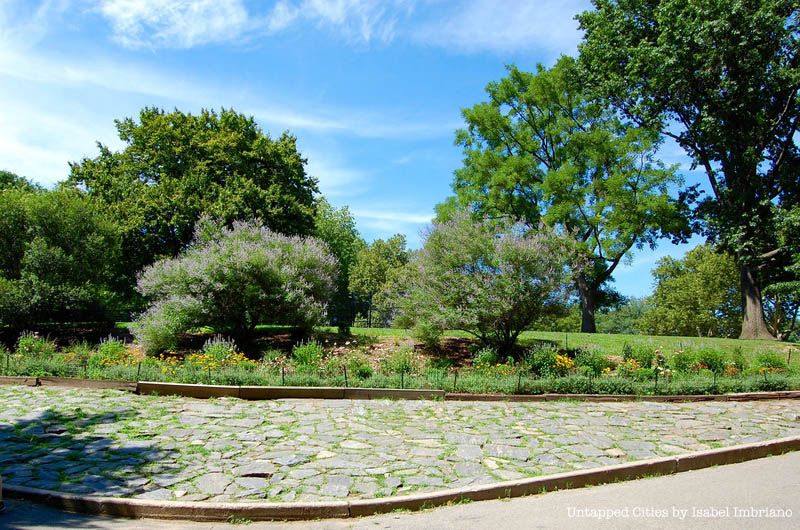
Located on the edge of Fort Greene and Downtown Brooklyn lies the borough’s oldest park, Fort Greene Park, which spans 30-acres and dates back to the Revolutionary War. It was on the high ground of this site that Fort Putnam was built in 1776 under the supervision of Major General Nathanael Greene. Likely named after Colonel Rufus Putnum, who was the chief engineer responsible for fortifying Long Island, the fort was taken over by the British after the Battle of Brooklyn. However, it was rebuilt for the War of 1812 and was later renamed Fort Greene.
In 1847, the city of Brooklyn bought the land that Fort Greene Park is located on to preserve it as a park, originally named Washington Park. It was the first to be designated by the city of Brooklyn, making it also the oldest in the borough today. Twenty years later, the famous designers of Central Park and Prospect Park, Frederick Law Olmsted and Calvert Vaux, reimagined a new design for Washington Park that would include a tomb for the prison ship martyrs who died on British war ships in Wallabout Bay during the Revolutionary War. The bodies were originally buried by Brooklyn residents in shallow graves in what is now the Brooklyn Navy Yard. But through erosion, bones began to emerge on the shoreline by 1808. The Tammany Society made the first motion that year to find a formal burial ground for the prison ship martyrs, a quest joined by Brooklyn citizens over the next few decades.

The park was renamed Fort Greene Park in 1896, and the 149-foot Prison Ship Martyrs Monument became its last installment in 1908. If you do wish visit the remains, The Society of Old Brooklynites hosts visits to it once a year but you have to be a member of the society to enter. The only requirement is that you have to have lived or worked in Brooklyn for the past 25 years. Discover more secrets about Fort Greene Park here.
Located very near the Prison Ship Martyrs Monument is bench dedicated author Richard Wright who wrote much of his novel Native Son sitting in Fort Greene Park which was a short walk from his apartment on Carlton Avenue. The bench features a quote from the novel which reads, “But hope was always waiting somewhere deep down in him.”

The oldest performing arts venue in America, the Brooklyn Academy of Music (BAM) first opened in 1861 for the Philharmonic Society of Brooklyn at 176–194 Montague Street in Brooklyn Heights. That building, which featured a 2,200-seat theater and concert hall, burned to the ground in 1903, prompting BAM to relocate to Fort Greene. Construction of the new facility began in 1906, and a series of events were held in 1908 to celebrate its opening.
Today, America’s oldest performing arts center operates as a multi-cultural site that caters to both local and international visitors, and serves as a gathering place for patrons from all walks of life. It’s also home to experimental and avant-garde musicians, as well as world-renowned programming in music, opera, theater, film, comedy and much, much more. Address: 30 Lafayette Ave, Brooklyn, NY 11217

Housed inside the now repurposed Strand Theater — a 1918 vaudeville theater, built by architect Thomas W. Lamb and once hosting acts like Harry Houdini — BRIC (Brooklyn Information and Culture) is a unique cultural space that provides a range of diverse programming related to contemporary art, performing arts, and video. Prior to the launch of BRIC House, BRIC Arts Media hosted its activities in several locations throughout Brooklyn. Today, however, the BRIC House provides a 40,000-square-foot space that includes a ballroom, a flexible artist workspace, gallery, a state-of-the-art public access television center and The Stoop, a public gathering space where free programming is held.
In the same building upstairs sits UrbanGlass, the United States’ first and largest glass studio. Established in 1977 by the New York Experimental Glass Workshop, the facility focuses on experimentation and exploration of glass as a creative medium, hosting over 200 artists and even more students. Not only can you take glass blowing classes here, you can also catch showcases and purchase funky glassware. Address: 647 Fulton St, Brooklyn, NY 11217

In 1999, the Museum of Contemporary African Diasporan Arts (MoCADA) was founded inside a Bedford-Stuyvesant building owned by the Bridge Street AME Church. This location, formerly a stop on the Underground Railroad, proved to be too small to accommodate a growing number of patrons, and thus, the museum moved to the ground floor of the James E. Davis 80 Arts Building in Fort Greene. Today, it presents a diverse range of exhibitions and educational programs that highlight the experiences and cultural contributions of people of African decent. Additionally, its programming places an emphasis on serving and reaching out to the local (and often underserved) community.

During the morning rush, there will likely be a line outside of BitterSweet, but that’s just a testament of the quality of its coffee. This narrow, hole-in-the wall cafe serves La Colombe coffee in addition to a selection of house made sandwiches and pastries. Patrons who frequent the cozy establishment rave about its cinnamon rolls and homemade almond milk that a Yelper claims to have “ruined for [her] any other almond milk.” Another draw is that it’s located at the southeast corner of Fort Greene Park, which means you can quickly grab a brew before heading off for a scenic, outdoor stroll. Address: 180 Dekalb Ave, Brooklyn, NY 11205

You’ll have no trouble finding good brew in New York City, but Urban Vintage is sure to make its way onto your list of favorite coffee shops thanks to its vintage vibe and selection of culinary offerings. Aside from its drinks, it also offers a menu of breakfast offerings and pastries, as well as pressed sandwiches, salads and wraps that are made from locally sourced ingredients. Beyond that, Urban Vintage is covered in knick-knacks and sells a curated collection of wares ranging from jewelry to stationary to novelty finds. Plus, large windows that filter light in and lots of seating options make this cafe an easy place to burn an entire day, whether you’re working or kicking back on a lazy Sunday. Address: 294 Grand Ave, Brooklyn, NY 11238
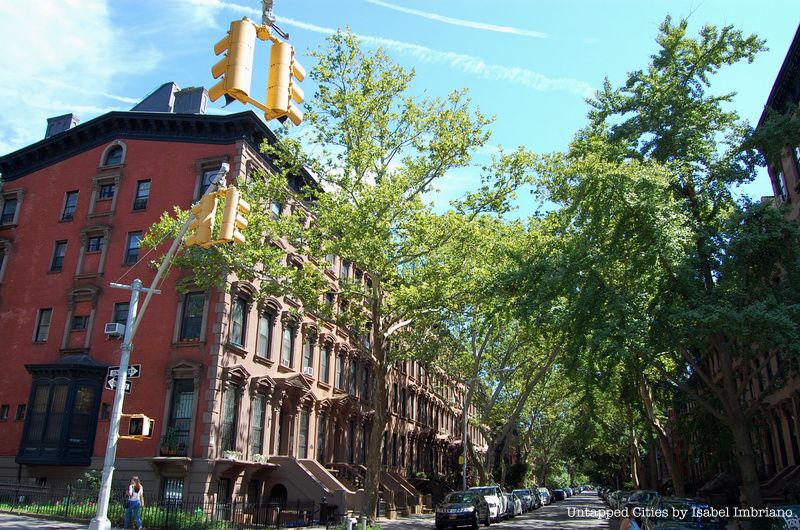
The New York Times calls Dekalb Avenue a “genuine restaurant row,” meaning there’s plenty to do, see and, most importantly, eat. It’s a commercial thoroughfare for the neighborhood, but still far enough from the subway that it feels slightly more remote. Although South African restaurant and neighborhood staple, Madiba, shuttered earlier this year due to financial issues, there are still a plethora of places to wine and dine at. As you walk east along the street, you’ll come across a variety of shops, cafes and restaurants, including the aforementioned Evelina and Maison May (formerly ICI).

The Fort Greene Historic District encompasses over one thousand buildings and is distinguished by its spectacular, multi-story brownstone and rowhouses that were built in the Italianate, Queen Anne and Neo-Grec styles. While Brooklyn is decorated with plenty of brownstones, the ones in Fort Greene are unique in that they possess detailed embellishments that have been kept intact beautifully since they were built between 1840 and 1890. In fact, of the numerous tree and brownstone-lined streets of New York City, the best across the five boroughs is located on Fort Greene’s South Oxford Street, between Lafayette and Dekalb Avenues, according to architectural historian Francis Morrone. Read more about the Fort Greene Historic District here.
While the Fort Greene historic district is dotted with many wooden houses, you will find the two oldest on Adelphi Street between Lafayette and Green Avenues. According to the Landmarks Preservation Commission’s designation report, the detached pair of transitional Greek Revival/Italianate houses at 329 and 331 Adelphi Street that were built together around 1848 are the two oldest wooden houses in the district. Both buildings were originally one and a half stories with peak-roofs. The report notes that the most notable features of each house are the four fluted doric columns on their porches.
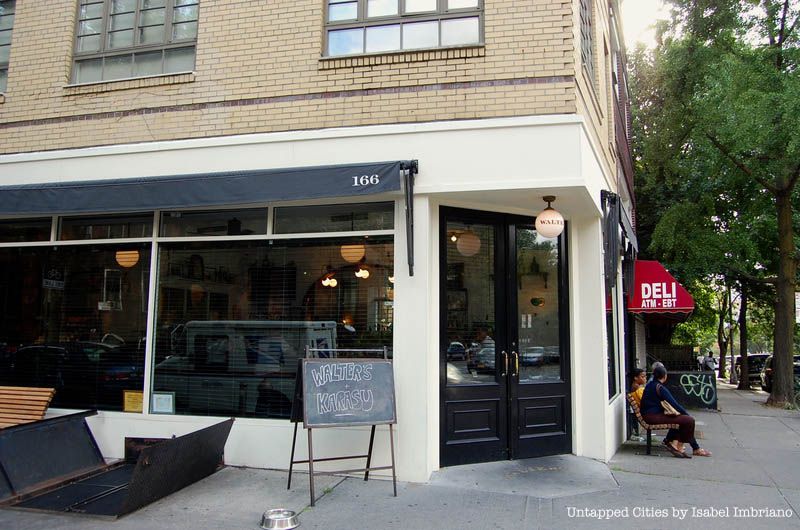
Fort Greene hot spots like Brooklyn Public House, Frank’s Cocktail Lounge, and Mo’s are certain to be packed on weekends. So for a different kind of bar experience, Karasu is a slightly more expensive, though worthwhile experience. To find it, customers must walk through the back door of Fort Greene’s Walter’s: an Italian restaurant concealing it. This hidden jewel and Japanese speakeasy offers a variety of seasonal food options, all of which are meant for sharing. Along with traditional Japanese fare, diners may order non-traditional dishes like fried pork chops and coleslaw.
Karasu also offers an extensive cocktail menu, including inventive drinks like the ‘Watermelon Man” and ‘Love Supreme’ served alongside classic Japanese drinks like sake, shochu and Japanese whisky to compliment your meal. If you enjoy Karasu, make sure to also check out other hidden Japanese restaurants in New York City. Address: 166 Dekalb Avenue, Brooklyn, NY 11217

Though not much of a secret anymore, Dick and Jane’s is another neighborhood staple with the feel of a speakeasy. Tucked away behind an unmarked wooden garage door, the dimly lit bar is decorated with tiled ceilings and exposed brick. The small, intimate spot features a narrow walking and seats by the large windows, which means it’s likely to be a tight squeeze on the weekend. Take that as a positive sign as the bar’s expertly crafted and seasonal cocktails make the experience quite worth the wait. Address: 266 Adelphi Street, Brooklyn, NY 11205
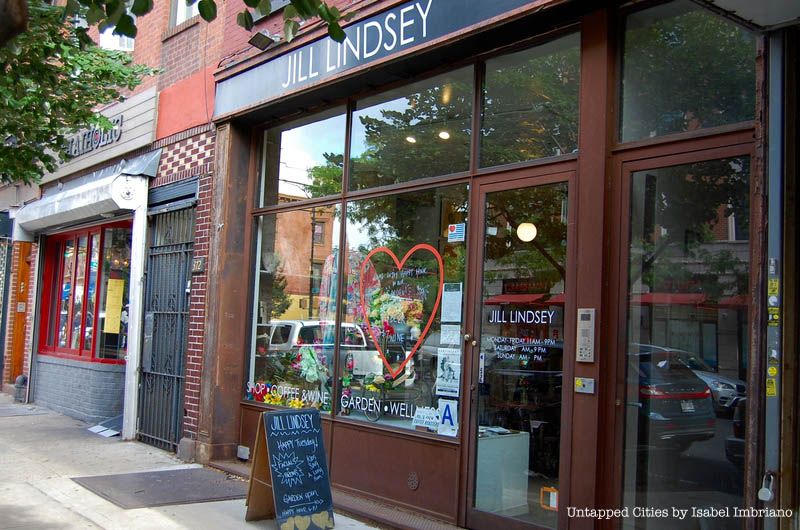
At Jill Lindsey, a clothing boutique in Fort Greene, there’s more than meets the eye. Designer Jill Lindsey runs the boutique and can be often found behind the coffee counter in the back. Serving coffee from Irving Farm, you can also drink alcohol here from the list of bio-dynamic wines and craft beer.
This is all to make the space more of a hangout than a store, and the events calendar attests with dinners, language classes, yoga, wine tastings and more. With Wi-Fi to boot and craft tables, it’s a nice spot to work and observe the community. It’s one of many quirky coffee shop combinations across New York City. Address: 370 Myrtle Avenue, Brooklyn, NY 11205
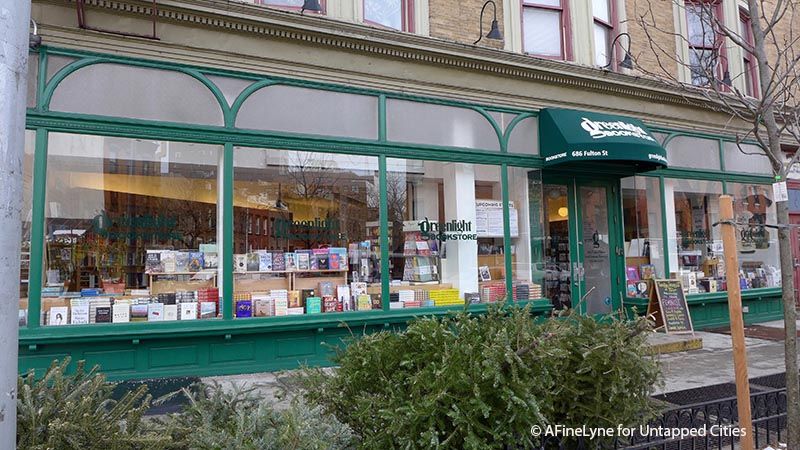
Greenlight Bookstore has a delightful story, beginning as a presentation, and ultimate winner of a Brooklyn Business Library Competition in 2007. Rebecca Fitting and Jessica Stockton Bagnulo opened the doors to Greenlight Bookstore in Fort Greene in October 2009, with overwhelming support from the community. The shop has also partnered with the Brooklyn Academy of Music, with kiosks in the lobby of the BAM Howard Gilman Opera House and BAM Harvey Theater, offering books and BAM related merchandise. For more on specialty bookshops, check out our guide here. Address: 686 Fulton St, Brooklyn, NY 11217
Next, discover some of New York City’s most quirky places with our must visit neighborhood guides.
Subscribe to our newsletter